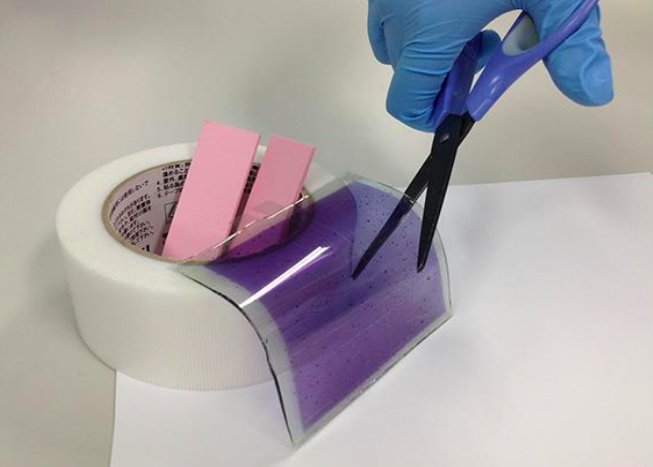

The four-sided screen has been a staple for decades, but soon we’ll no longer be relegated to a quadrilateral field of vision. Scientists at The National Institute for Materials Science in Japan have manufactured displays that can be trimmed to fit any shape.
Dr. Masayoshi Higuchi, along with a team of researchers, created a multi-layered sheet screen that contains pigment particles. It’s not an LED screen, nor is it e-ink — it’s an organic-metallic hybrid display that responds to electrical inputs, such as from an AA battery or jumper cables, and doesn’t need a continuous charge. A plastic polymer layer sits on top, and is smooth and flat and conceals the metal ions (electrochromic layer) that move across the bottom of a gel electrolyte layer. A final plastic polymer layer underneath seals the deal.
“We wanted an insulating transparent film that we could cut into any shape and could also exist between the electrochromic polymer layer and gel electrolyte layer,” Higuchi says. “This is what creates the shape display.”
Using ordinary scissors, the screen can be cut in half, and still be programmed to show separate words or images on each of the display halves. In order to change or reprogram what’s on the screen, a current of electrons is needed to move the metal ions to a formation designated by a predetermined film in the polymer. For now, jumpers are applied to the screen to run a 3V charge through it for a few seconds, which in turn causes the metal ions to move and the display to update. When the jumpers are removed, the screen retains whatever was displayed on it last for up to several days, as the metal ions stay in place within the polymer until charged again.

Why would anyone want a cuttable display? Other than it being cool, these screens don’t use liquid, like LCD screens, they can be configured to any size or shape, they’re more energy-efficient as they don’t need a continuous power supply, like an LED screen, and are resistant to moisture and oxidization.
The electrochromic screen could be used for a wide range of applications; a retail storeowner could place it in their store window to alert customers when a sale is happening, or carmakers could place it in the corner of a car window to inform drivers about weather updates or traffic alerts. In the case of a retail store, this could help businesses save on advertising and printing costs for each new marketing push, as they can make the polymer cheaply and fit to any size, something that wouldn’t be possible if they were to buy and power costly LCD screens with pre-determined sizes. For cars, it means that once electric cars become more prevalent, less energy would need to be used to power internal displays. Since the screen would also be fairly cheap, Higuchi mentions that there might be a market for DIY makers as well.
Though the screen can only use one type of ion currently, Higuchi says they’re already working on a multi-color version. “It might be possible to make a full-color display in the future because we have polymers that are close to RGB colors.” They’re also experimenting with creating an XY-matrix on the next display, so that more complicated designs can be programmed by computer. Wall screens, here we come.
